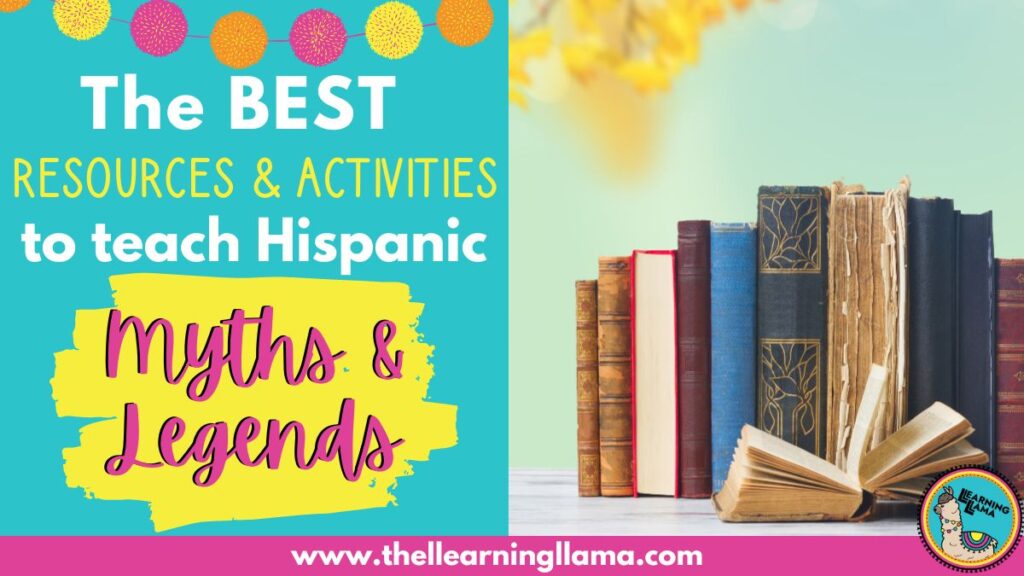Fall always reminds me of spooky stories or myths and legends around a campfire. My mom is known for her storytelling around the campfire. She has a way of captivating her audience and keeping us on the edge of our seats to hear the ending! A good storyteller shares a story with such detail and emotion that the story lives on for generations to come.
Myths and legends don’t have to be spooky. But they tell an important piece in the cultural story of a country or group of people. Many times, myths and legends will tell about the creation of natural wonders of the world or teach a valuable lesson to the listeners.
Teaching myths and legends in Spanish class is the perfect storm of culture and communicative tasks. Since these myths and legends are so near and dear to the country or culture they belong to, students get an up-close look at the culture. Plus, with reading or listening, discussion, and cultural comparisons, the communicative possibilities with myths and legends are endless!
The Best Hispanic Myths and Legends
Myths and Legends about Natural Wonders
There are so many creation myths about natural wonders and landmarks. Here are some of my favorites:
- Izta y Popo: An Aztec legend about the creation of Iztaccíhuatl and Popocatepetl volcanoes in Mexico
- Rainbow Mountain: An Argentinean legend about a colorful mountain
- Iguazu Falls: A Guarini Indian legend about the creation of waterfalls
- Lago Titicaca: An Inca legend about the creation of the highest navigable lake in the world
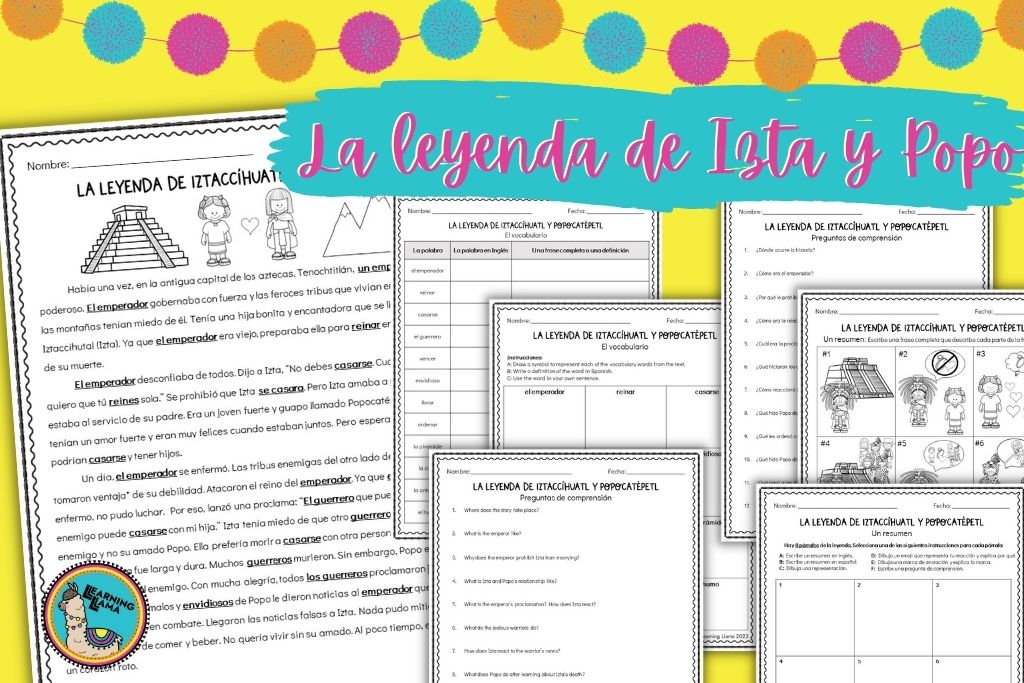
These four legends come with differentiated versions of the text, vocabulary activities, comprehension questions, and images to retell the story. Purchase the complete set of these 4 myths and legends in Spanish or English.
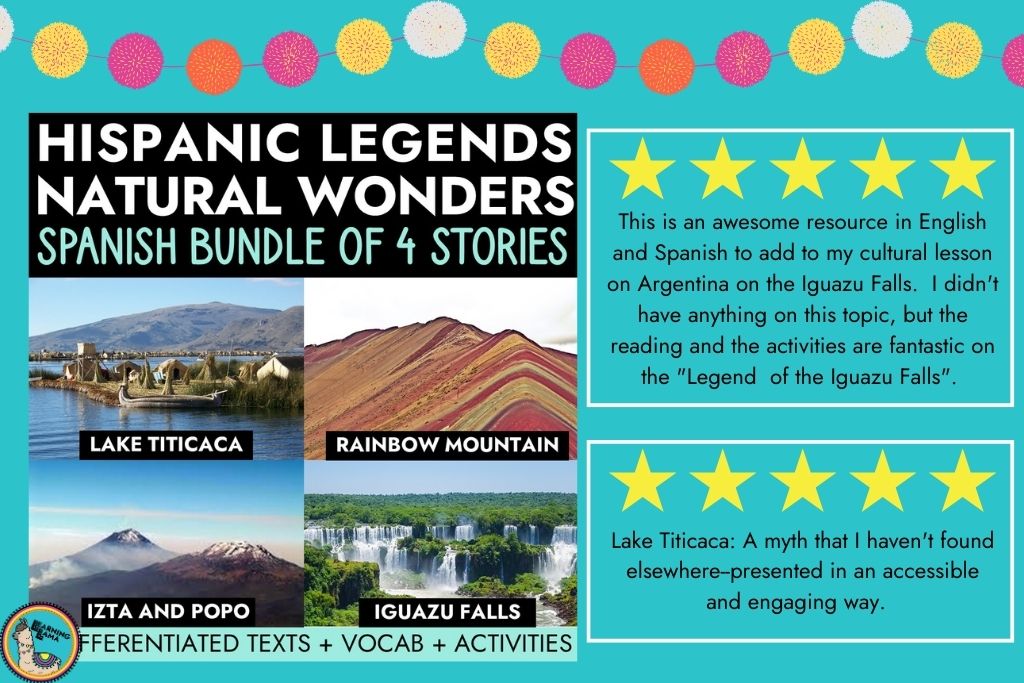
Myths and Legends About Hispanic Celebrations
When holidays roll around, we tend to take a break from curriculum and introduce the Hispanic celebrations associated with that time of year. But our teacher brains are usually fried by this time. So, reading a legend that touches on culture, vocabulary, comprehensible input, and more can make the week leading up to break easy, engaging, and cultural!
- Legend of the Poinsettia (Flor de nochebuena Christmas flower)
- Legend of the Marigold (cempasúchil Day of the Dead flower)
- Legend of the Marimonda (Carnaval de Barranquilla character)
- Legend of the Ghost of the Quinceañera (use any time of year… a spooky tale!)
- Get the Hispanic Holiday Legend Bundle in Spanish or English
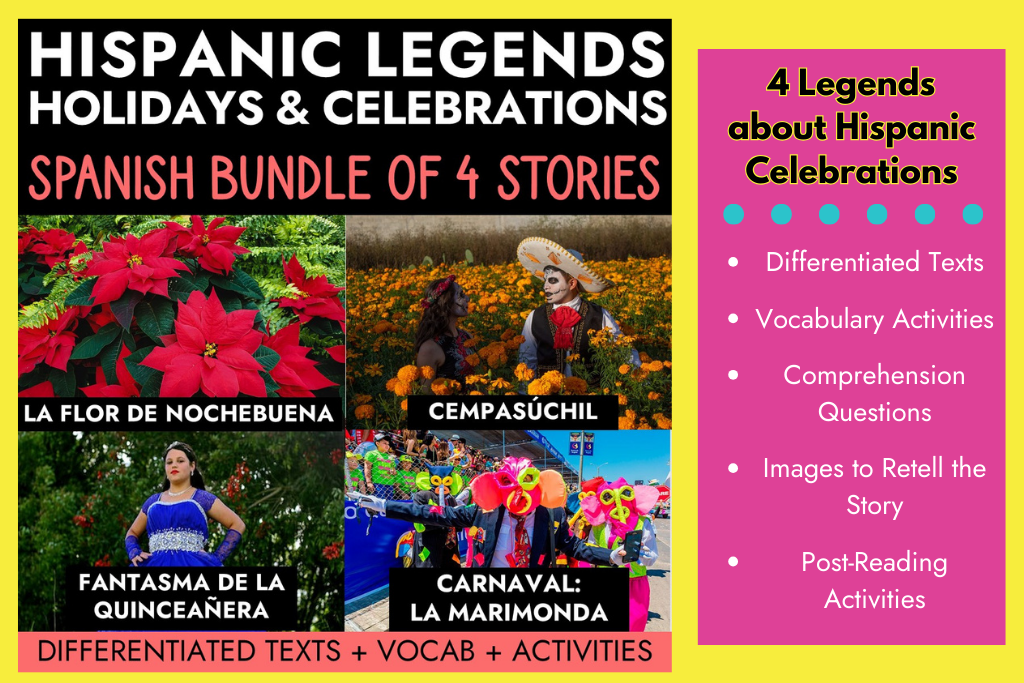
Resources for Myths and Legends in Spanish
Books
- I found this book called “Leyendas del mundo hispano” at a library book sale. It has many legends for intermediate high to advanced students. I used the Izta y Popo legend and edited it for my Spanish 4 class. It comes with 12 legends, all from different countries, with accompanying pre-reading activities, vocabulary, and questions.
- Cuentos y leyendas de América Latina is a book with very short stories – perfect for a quick read!
- Mitología mexicana para niños has a great collection of Mexican myths and legends. They are broken down by theme, so you’ll be sure to find any type of story!
- Leyendas de los Incas, Mayas, y Aztecas contadas para niños has a compilation of great legends with bright illustrations.
Websites
- Vista Higher Learning compiled a list of Latin American myths and legends by country.
- Guia Infantil has a great selection of myths and legends from Spanish-speaking countries and pre-Hispanic civilizations.
- Spooky myths and legends like La llorona and El Silbón are great for fall! Here is a list of 13 spooky legends.
- My TpT store has a variety of myths and legends in both Spanish and English. Each come with 2 versions for differentiation, vocabulary activities, reading comprehension questions, and retell images with worksheets! You will have a complete lesson with these legends!
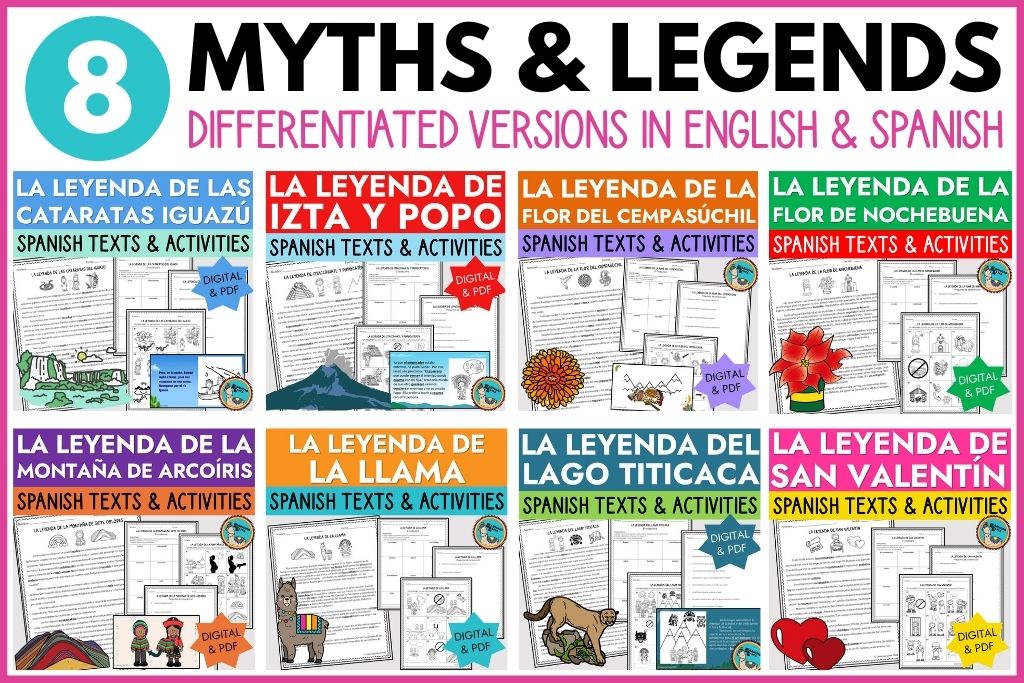
How to Teach Myths and Legends in Spanish
Storytelling Strategies
Many myths and legends have been passed down orally from generation to generation. For a story to be upheld to such importance that it continues to be told centuries later, it must be told with such conviction and emotion that it captivates the audience. It must be told in such a way that people won’t forget it. In such a way that people continue to tell it to future generations. It is evident that storytelling plays a huge role in myths and legends throughout history.
Therefore, we must make storytelling an essential element of our myths and legends unit. Model storytelling techniques for your students. Bring them back to the days of a read-aloud, like in elementary school. Choose a picture book legend or myth. This version of La Llorona by Joe Hayes is one of my favorites.
Joe Hayes is a captivating storyteller. Just watch this video. Without any props, visuals, or subtitles, he can captivate his audience and engage them in the story of La llorona. As you watch this video (or clips of it), have your students identify his strengths as a storyteller. What does Joe do when telling this story that captivates your students?
Take this a step further and have your students retell the myths and legends that you read together. They should use the same techniques they admire in a great storyteller.
TPRS
Teaching Proficiency Through Reading and Storytelling) is a second language acquisition method. The method uses storytelling as a teaching tool. As I just mentioned, storytelling techniques are extremely important for students to learn. One way you can model storytelling for them is with TPRS techniques.
Here is a 5-minute video of Martina Bex using TPRS methods, where she involves her students in the story as much as possible. If you just read a story to your students, they might zone out. But when you start to ask them the most basic of questions, they will feel like they truly understand. They will be able to say, “Okay, I know what is going on in the story, let’s keep reading.”
I use TPRS with a lot of images on the projector board or props in my hands. I repeat key terms over and over, and I ask really basic questions. For example, if I’m starting the story by saying the two women were sitting on the beach. I will then ask my students are they sitting at the beach or the park? Is there sand at the beach? Is it hot at the beach? I will recycle some of these questions again and again, reusing key terms.
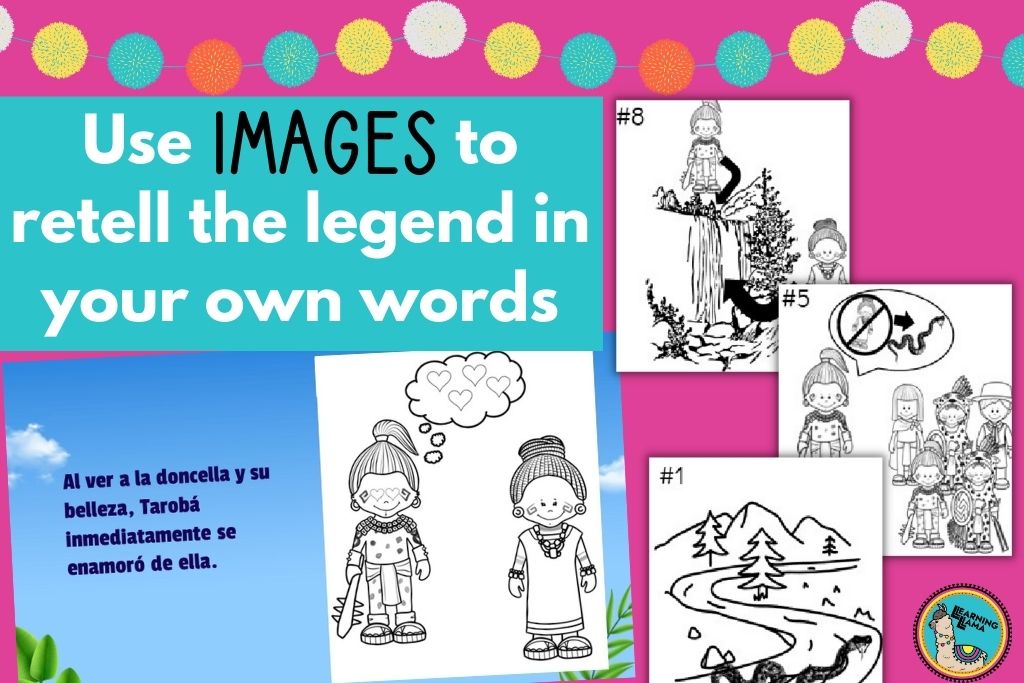
Retell the story in your own words
After you have read the myth or legend with your students (maybe even multiple times), they are ready to retell it in their own words. Show them images of the story to use as a starting point. Or assign each group a section of the story to illustrate and retell. Here are some ideas for retelling myths and legends.
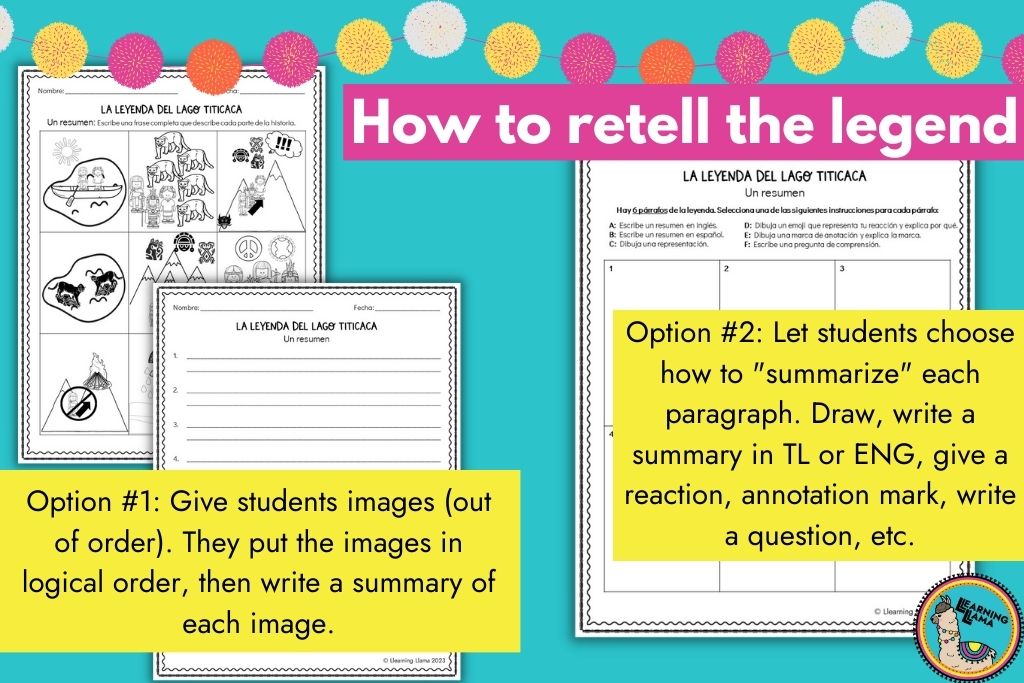
Cultural Comparison
There are many instances where myths of legends from one cultural mirror the myths or legends of another. Take for example the story of creation. This legend is told in almost every culture, with different names, characters, locations, etc. The moral of the story is the same, and the general plot is, too. Have students choose a myth or legend from Hispanic culture that you read to compare to a short story they are familiar with from their childhood.
Write Your Own Legend
Many myths and legends tell about the formation of a natural wonder. Provide students with a list of natural wonders or let them choose one of interest to them. They will write a legend in Spanish, explaining how this wonder came to be. I have done this with my students, and I was always amazed with their creativity with this project.
If you choose to do this project, be sure to first discuss common themes of legends: love, creation, jealousy, power, revenge, etc. You will also want to create a list of requirements (characters, length requirement, vocabulary, etc.) so students know their expectations. Finally, give them time to brainstorm before writing their first draft. Let them think about the title, main characters, plot, history of the natural wonder, 3 interesting facts about it, theme, moral, etc.
Reading is one of my favorite skills to teach! If you are looking for more interpretive reading activities, check out these ideas:
- Read Mystery Stories in Spanish Using These 6 Authentic Strategies
- How to Find and Create Authentic Interpretive Tasks for Spanish Class
- Why You Must Try These Strategies for Close Reading in Spanish Class
This post may have affiliate links. If you make a purchase from these links, I may receive a small commission. Thank you for supporting me, a fellow educator!

